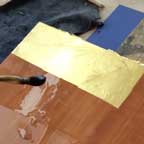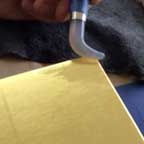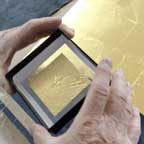Introduction to Gilding with Gold Leaf

Gilding is the application of gold, silver, or other, leaf to a surface. It can be as simple as adding touches of gold to a painting, table decoration, or to a flower. Or it can be as complicated as covering a baroque picture frame, a statue, or a state house dome in gold leaf. Regardless of the project, the basic process is the same. Adhesive is applied to a clean and smooth surface of the item being gilded. The gold leaf is then pressed on to the adhesive, and the excess leaf is brushed off.
Surface Preparation
As with painting, surface preparation is important. A clean smooth surface works best. Because the gold leaf is very very thin, any imperfections in the surface will show. Just like painting over a crack in a wall, the crack will still show after it has been painted. The surface preparation will differ depending on the base material. Wood, metal and glass are the most common.
For wood, it is best to prime and seal the wood. Our Base Coat Primer Sealer is great for this purpose. Depending on the roughness or porosity of the wood, you may need multiple coats. After each coat is applied, the surface should be sanded to make it as smooth as possible. After the final coat is sanded with a very fine sandpaper, be sure to remove any remaining the dust or other particles. Yellow Basecoat will help hide small flaws and mistakes when gilding with gold. Red Basecoat will change the color tone just a bit. Gray Basecoat is generally used with silver, palladium, or other white metals.
When gilding a metal object, the surface needs to be clean and smooth. Many gilders use shellac as the base coat, as it is a wonderful sealer. The surface should be lightly sanded and clean to allow the shellac to adhere properly. Once the shellac is applied and dry, you can lightly sand with a very fine sandpaper and then apply the gilding size.
Oil Gilding on Wood or Metal
For wood, metal, plastic or other items being gilded, you can apply the size after your base coat has been applied, sanded and cleaned. For small projects, it is best to use Quick Size, which should be applied very thin. Some gilders apply the size with a brush and use small foam roller to remove most of it.
Information and instructions for using Oil Base Size can be found here.

Water Gilding on Wood
Water gilding is different than oil gilding, requiring additional preparation. But as with oil gilding, the surface should be as clean and smooth as possible.
Gesso, which is made from Rabbit Skin Glue (RSG) and very finely ground calcium carbonate (whiting), is applied to the surface, usually in 4 to 6 coats, which are then sanded with fine sand paper when dry. After the final coat of gesso has dried, several coats of clay bole mixed with Rabbit Skin Glue are applied on top. Once the clay bole has dried and been sanded smooth, the surface is ready for the gold leaf to be applied.

Clean, or preferably distilled, water is 'painted' where the leaf will be applied, activating the adhesive properties of the Rabbit Skin Glue in the clay bole. The gold is placed on the surface with a gilders tip, where it will be pulled on to the surface.
As the excess water drains off and the surface dries, the gold leaf will be come bright and beautiful. Using a Gilders Dusting Oval Mop, the excess gold leaf is removed, and if desired, the surface can be polished using an agate burnisher.

Water Gilding on Glass
Water gilding on glass is an art that produces unique and beautiful works of art. Using a cleaner such as Bon Ami, the glass should be completely cleaned and free of dirt, contaminants, dust and oil, including oil left by fingerprints.
The glass is placed at an angle, and gelatin glue is applied with a mop, to what will eventually become the back side of the piece. Working from the top edge, the gold is then applied using a gilders tip, or a Thorn Tip.
As the water drains and the gold dries, it will become bright and shiny. Excess gold can be gently removed with a Gilders Dusting Oval Mop.
When completely dry, the glass can be silk screened, or painted. After the paint has completely dried, a Gilders Removal Brush can be used to gently remove the excess gold leaf, leaving only the leaf protected by the paint. When looking at the front side, only the gold that is backed up by the silk screen ink or paint can be seen. Additional painting or silk screening can be done to create a unique piece of art.
Sealing Your Gilding Project
Sealing will prevent oxidation and color change in leaf that does not have a high gold content. It is especially important when using silver leaf, copper leaf, imitation leaf, 12k and 18k leaf. For indoor use, 22k and higher does not need to be sealed.
Topcoat Sealer can be applied to your project using a brush, roller, or by spraying.
If sealing a project to protect from damage or handing, acrylic urethane or a clear automotive paint is a better choice.
Sealing gold or silver will result in some loss of brightness and shininess.
